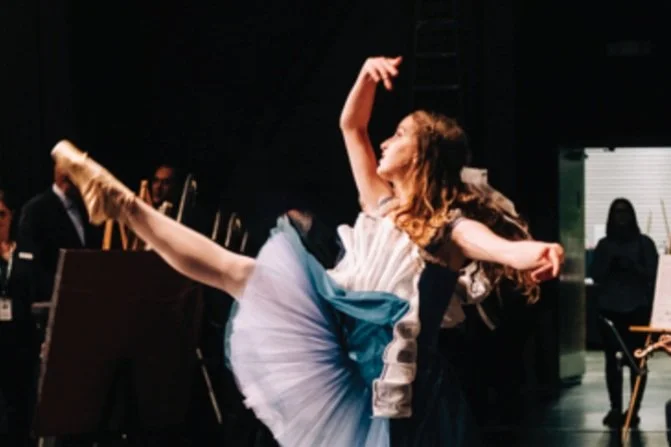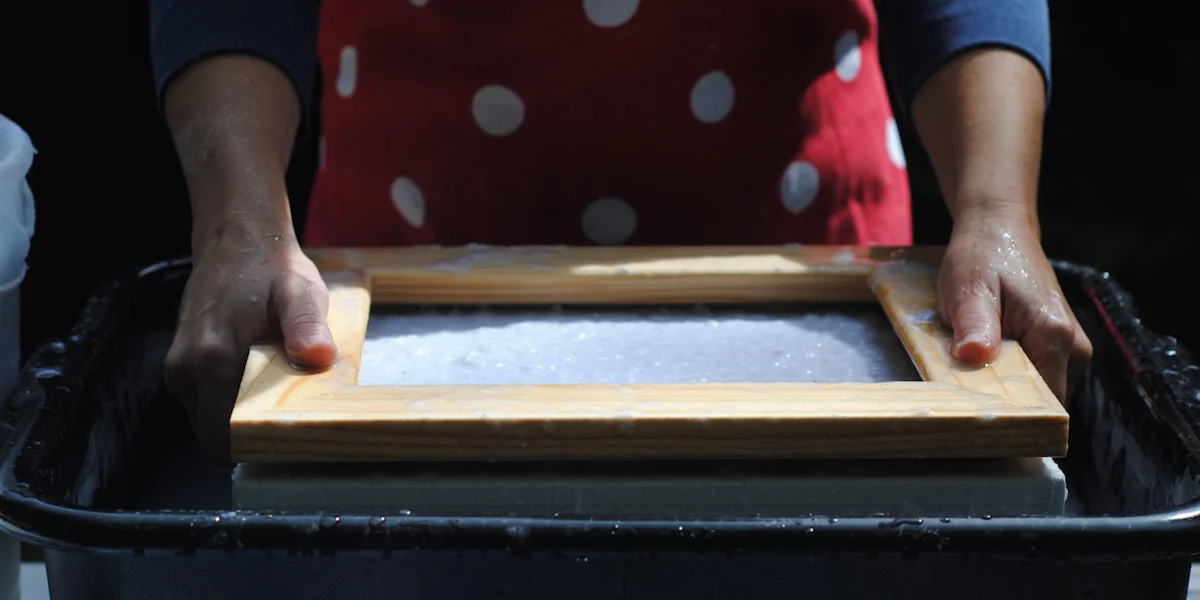Visual Dialogue
This piece was originally published in the April - July 2017 issue of Our Jackson Home: The Journal.
Professor Haelim Allen’s office, like the rest of the art department at Union University, is in beautiful disarray. There are paintings on the walls, half-completed sketches on her desk, various models in differing states of completion on a bookshelf, and of course a second bookshelf overflowing with literature that seems a staple of every teacher’s office. Just outside of her office door is a gorgeous light box which fills the hallway with a sense of peace and calm. The building itself is not by any stretch beautiful, but Professor Allen has transformed her office and the hallway leading up to it into a peaceful, welcoming environment. The instant I stepped into her office, I was aware of some external force that drove Haelim Allen to make things with such purpose and beauty. When I stepped into the room to interview her, I dropped all of my previous questions and vowed not to leave until I discovered who Allen is as an artist.
Haelim Allen was born in Daegu, South Korea, the fourth largest city in South Korea, and moved to the United States in 1976. “I identify my hometown more in D.C. than in Daegu,” Allen says. “Most of my childhood memories come from the Maryland side of the D.C. suburbs.” She remained in the Washington, D.C., area until grad school when she made the move to Illinois to attend Trinity Evangelical Divinity School. There she met her husband, Dr. James Allen. Over the first seventeen years of their marriage, the Allens moved fourteen times before finally settling in Jackson seven years ago.
One of the first things I noticed in Professor Allen’s office was a small painting hanging behind her desk. “That’s part of the first series of paintings I did,” said Allen, leaning back in her chair and looking at the painting. “My goal was to try and recollect those places and times in Korea through my mother’s black and white photos. Translating my parents’ photographs in a particular setting prompted me to recollect whether I remembered that particular event or not. It’s not just a memory anymore, now it’s concrete.” The painting I first saw was of Allen walking down a country lane as a child. “It’s not a means of being photographic in my paintings, as it’s interpretive,” said Allen, pointing at the surreally colored painting. “It’s about engaging with my memory and creating something new out of the photos and their recollections.”
While she enjoys drawing, painting, and other two-dimensional art, much of Allen’s focus in the past few years has been on installation art. Some of these pieces have been displayed in Memphis, New York, and Baltimore, as well as in Jackson on Union University’s campus.
Assimilation was a sort of three-dimensional representation of comfort to Allen’s mother, featuring her passport photo. “Here I am, going from a series of paintings based on my mother’s photographs to my mother’s passport photograph,” said Allen. “What can I do to comfort her?” It’s a piece that’s tied strongly to personal experience, moving from South Korea to the United States and having to deal with many of the complexities and difficulties that arise from having to assimilate to a new culture.
One of Allen’s favorite aspects of installation pieces such as this are the very raw, real emotional connections and conversations she can have as an artist with people who are experiencing the art. During one of the showings of Assimilation, a Japanese-American mother came up to Allen, crying. “She said ‘I’m going through a disconnect with my daughter,’” recalled Allen, “and this piece had really affected her. She came up to me crying, and it was a point of ministry. I think Christ came into the conversation when I comforted her and told her it was going to be okay. I relayed my experiences with my own mother, how we felt remote at times because there were language barriers and other sorts of issues.”
One of her installation pieces, Cinderella Complex, has generated an interesting response from young children who have either seen the installation itself or have seen the slipper prototypes in Allen’s office.
With each of her pieces, Allen wants to bring people together to have beautiful, meaningful encounters with others. This can be seen in Cinderella Complex. “Why is it,” asked Allen, “that a kid can run up to those shoes and say it’s Cinderella? Why does that happen?” As with much of her work, Cinderella Complex was meant to cross boundaries. “I try and pull things together,” said Allen, “so even though the shoes are culture-specific, they’re also universal, so they can relate to all people.”
Allen wants to make artwork that can provoke conversations in any setting, with any people. Huff, Puff, Blow is an example of the sort of art she enjoys creating, combining the story of The Three Little Pigs with childhood fears and the Sept. 11 tragedy. During a showing of the piece, Allen was approached by a man who had questions about the installation. He recognized that there were aspects about the piece which tied into the Sept. 11 tragedy but could not understand why there were three towers. “There has to be three towers because it’s relating back to the pig’s story,” said Allen, laughing recalling the incident. “And what if we still had one tower? What if there was a third tower? These are ideas crossing racial, ethnic, and age boundaries.”
“The image on one of the wish boxes was a photo from when I felt the terror of not knowing where my mother was, even though she was taking a photo of me,” said Allen. “Blending that [childhood terror] with the towers, with the narrative, with the stars and stripes, those are aspects of what I love. Pulling many things that I love into one work.”
One of Allen’s more recent pieces, Death to the Domestic Goddess, was a byproduct of living in West Tennessee. A student at the University of Memphis approached a then pregnant Allen and said, “Around here that’s what they expect, for you to get pregnant and for you to be a housewife.” Allen was puzzled by this view of Southern culture and began this installation project, wrapping skirts and other white fabrics around old cast-iron skillets. “I decided to juxtapose that [student’s critique] with this notion that I grew up with that women can do everything,” said Allen. “People say you can be a professor, a wife, a mother, a servant of God within the church complex, and I’m going, ‘I don’t know how I could do it all.’”
Allen emphasized the fact that she was not trying to be critical of either side of the argument. “For me, as a professional artist,” said Allen, “I want to communicate something. I want to start a conversation. I want to probe the work to glean something more.” When the work was shown in Jackson at a Union University art gallery, it was met with perplexity from a wide range of viewers.
“Doing this piece,” remembers Allen, “lots of people were puzzled. They looked at the title and asked, ‘What does she mean by death to the domestic goddess?’ It started a conversation. It’s not meant to be negative, and I was trying to prompt people and say, ‘There might be something else to this issue.’” Without saying anything, Allen used artwork to start a meaningful conversation right here in Jackson, Tennessee.
I’d already seen how Daegu had influenced Allen’s work, and this was an example of the influence of Jackson, at least to a limited extent. “Would the domestic series have come out if I was not in the region?” she asked herself, trying to discover what really drove her as an artist. “I don’t know. I can’t claim that the two works were inspired by the region. Yes, the student was from Memphis, and yes, whatever I was thinking or going through relates to my experience. So it’s personal to me, but I need to make it more universal. I think a dialogue needs to happen.” And that’s exactly what Allen did with this piece and all the other ones: start a dialogue.
Ultimately, it’s not her surroundings that inspire Allen’s work. “It’s not always where I am that solicits these ideas,” says Allen. “I think it’s the [Holy] Spirit that prompts me to say something in my work.” While South Korea, the D.C. suburbs, Memphis, and Jackson have all been an integral part of her life, the one constant in her life has been the Holy Spirit. “This is my visual ministry,” Allen says. “Where the Spirit leads, when the Spirit comes, is when I get feedback from others. Maybe not directly, but they’ll tell someone I know, and they’ll tell me.”
The moments of community that arise out of Allen's interactions with her audience are why she loves what she does. “I look forward to those types of experiences. I thank God for her approaching me, for the kids responding, for his coming to me,” she says of those who have approached her about her work.
Professor Haelim Allen’s goal is to inspire community with others through the power of the Holy Spirit. “If my art makes somebody’s day calm, then I am the most grateful, and it’s not because my wrists hurt from wrapping pans or hand-sewing dresses. I forget all the labor because it’s really all about that dialogue. I don’t feel like it centers from me. It centers from the Spirit.”
When you step into Allen’s office or explore one of her installation pieces, you feel the sense of community that she has built to foster conversation. Her unique brand of artwork provides a public forum to discuss ideas that transcend all socially constructed boundaries, leading to a healthier community.
To learn more about Haelim Allen and the rest of the Union University Art Department, visit their website.
Clark Hubbard is a Political Science and English double major at Union University. He loves all kinds of writing, especially short stories, screenplays, and political essays. Clark also participates in a ludicrous number of extracurricular activities for which he has no time, including debate, improv, and making coffee as a barista on campus. Clark's spirit animal is John McClane from the Die Hard series.
Photographer Cynthia Sipes is a native of Alabama who moved to Jackson in April of 2016. She works at Starbucks full-time while pursuing an MA in Art Therapy. She is happily married and enjoys photography along with other creative endeavors.



















